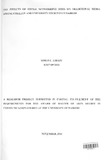| dc.description.abstract | This survey sought to find out the effects of social networking sites on traditional media. The study targeted college and university students in Nairobi. The government, non-governmental organisations, and private companies use conventional media to communicate with masses through public education, information and advertising, among other uses. The main objective of the study was to investigate media use patterns among college-going students and how their use of new technology affects the traditional media.
To achieve the goal of the study, the researcher focused on five key objectives that involved identification of uses and gratifications among the college and university students, investigating the displacement effects of the new media upon the conventional media, establishing how emergence of new media technology impacts on the use of the existing media, finding out the displacement effects of the new media upon the old and to identify the emerging trends in use of modem media technologies compared to the older.
The research identified three theories relevant to the study namely the Uses and Gratifications, Displacement and Technological Determinism theories. The Uses and Gratifications Theory was important in identifying the satisfaction and motivations of the respondents in use of the new and old media as well as assess the impact of social media use on the traditional media. And given that the possible effect would be audiences shifting to the new media at the expense of the old, Displacement Theory came in handy to establish whether users are likely to embrace the social media and lead to the demise of the old media. Technological Determinism Theory was significant in explaining the role of computer mediated communication and the impact of its use on human communication.
The study was based on descriptive research, which involved administering questionnaires and face-to-face interviews to generate both quantifiable and qualitative data targeting student respondents aged between 18 and 35 in learning institutions within Nairobi County. The design sought to gauge their perceptions and attitudes in old and new media use.
The study yielded two major findings based on the areas that were investigated that give a more or less similar findings by other related studies, so far. In terms of motivations for media use and gratifications, the research found out that each medium plays a special role in meeting the needs of the audience despite the fact that all the media compete for their attention. The study also established that the old and new media complement one another and are interdependent. To retain and increase audiences, the old media are adapting the new technologies and perfecting the functions that they play better than the social media, therefore, minimising the displacement effects of the new media.
The researcher came up with several recommendations to media managers and other stakeholders in the industry. The study recommends that managers of the traditional media should fully engage audiences in the social media platforms and direct them to their various products. Another important recommendation of this study is for the media organisations to be dynamic and proactive in their marketing strategies by emulating technology companies. They should empower their audiences* with tools and gadgets such as in-house software applications to enable them use the new technology like iPads and mobile telephones to access media content they generate. | en_US |

